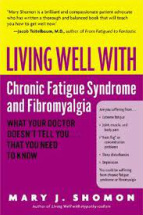
Living Well with Chronic Fatigue Syndrome and Fibromyalgia is a good basic introduction that covers a lot of ground without losing coherence. Written in an accessible style and well organized, Shomon's book is probably the best place to start if you haven't already done a lot of reading on the subject.
The strongest parts of this book are the chapters that explain the "nitty gritty" of CFS/ME: etiology, how the immune system works, and the origins of various symptoms. Shomon manages these complex topics competently, without devolving into excessive technical jargon.
Her discussion of causes covers all the "usual suspects" - bacterial infections (mycoplasma, chlamydia and tick-borne infections), viruses (HHV-6, Q fever, and stealth viruses), and candidiasis. But Shomon really shines when she discusses the effects of CFS/ME: immune system dysfunction (autoimmunity, low NK cell function and the Th1/Th2 shift), endocrine disorders (hypoadrenalism, hypothyroidism, and human growth hormone deficiency), central nervous system dysfunction, allergies and chemical sensitivities. These are the aspects of CFS/ME in which Shomon shows the greatest interest and expertise (undoubtedly due to the extensive research on all these areas).
There are weaknesses inherent in a broad survey of this type. The first is that Shomon, like Dr. Teitelbaum (who wrote the Forward) lumps CFS/ME and fibromyalgia together as CFS/Fibromyalgia. This is a mistake. Although there may be a great deal of overlap in symptoms, CFS/ME and fibromyalgia are not the same illness. (This distinction is borne out by research studies which show different results for the two groups.)
Many people with CFS/ME do not experience fibromyalgia pain. More significantly, people with fibromyalgia tend to improve after exercise while those with CFS/ME suffer a decline. (Exercise intolerance is the hallmark symptom of CFS/ME.) What's more, while I have met many people with CFS/ME who have fibromyalgia as a secondary diagnosis, I have yet to meet a single person with fibromyalgia who has CFS/ME as a secondary diagnosis. CFS/ME is clearly the heavyweight here.
The second weakness in this book is that Shomon's discussions of treatments are cursory at best. At times she only devotes a sentence or two to treatments which have been utilized for decades and omits others entirely. In this regard, "what your doctor doesn't tell you" is a misleading subtitle for this book. If you see a CFS/ME specialist, chances are that he or she will tell you a great deal more about treatments than Shomon does.
Aside from these two admittedly serious faults, the book stands up well as an initial introduction. However, I would advise anyone with either CFS/ME or fibromyalgia to continue reading. There are a number of other books that discuss both illnesses more thoroughly.
Living Well With Chronic Fatigue Syndrome and Fibromyalgia can be found on Amazon here and on Barnes&Noble here.

 RSS Feed
RSS Feed
